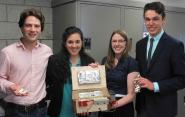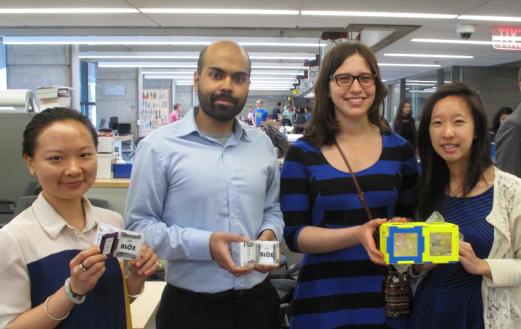Green Engineering Students Address Sustainability Challenges

Awareness of environmental impact has become an increasingly important concern during the process of engineering any new technology.

But as the final projects for students in “Green Engineering & Sustainable Design” show, a concern for the environment is also an effective tool for inspiration.
The Green Engineering course — cotaught by Julie Zimmerman, a professor of chemical & environmental engineering & forestry & environmental studies, and Paul Anastas, the Teresa and H. John Heinz III Professor in the Practice of Chemistry for the Environment, School of Forestry & Environmental Studies — is a product design course that, within the context of environmental mindfulness, addresses how to solve sustainability challenges without causing harm to the environment or human health. This year’s projects represented diverse approaches to four design challenges: sustainable household water and energy use, upcycled household waste, reductions in food waste, and greener e-commerce packaging and shipping.
This year’s course was also unique because of its greater use of the tools in Yale’s Center for Engineering Innovation & Design (CEID). “We’ve taught this course for nine years, but this year, trying to take full advantage of the tools and learning opportunities in the CEID, we gave the students more time working with their teams in the Klingenstein Design Lab,” said Zimmerman. “The results are stunning, and it’s clear that the CEID is helping us take this class to the next level.”

The Upcyclist team was one such group whose prototype wowed those attending the course’s final presentation. Their forward-thinking device melts plastic bags like those you get from a grocery store, then forms the melted plastic into strong “bricks”; however, the heat is well below the plastic’s glass transition temperature, meaning that though the plastic softens and can be shaped, it doesn’t actually melt to the point of a potentially noxious state change. As well, this way of making an upcyclist plastic brick requires only 3.6% of the energy it takes to make a traditional clay brick.
The Upcyclist solution is particularly notable because it not only reduces plastic bag waste, but it also results in the low-cost building materials that are in short supply in developing nations. These plastic bricks could even be formed in interlocking shapes, thereby also further reducing construction costs.

By contrast, the Blöx team created a new packaging system that, instead of reusing current waste products, could make unnecessary the production and ultimate disposal of thousands or even millions of tons of cardboard and packing materials. The team’s innovation was developed in response to the problem of flexibility — because packages come in standard sizes, shipped objects often must be surrounded by insulators to prevent damage. But what if the box could be customized to the exact size and shape of the shipped object?
The result is a reusable modular casing system designed for assembly and disassembly. Using interlocking PLA plastic panels, a vendor could build a shipping box to any size or rectangular shape, decreasing the excess space around the shipped object and lowering or even eliminating the need for packing peanuts and bubble wrap. Such packing would be especially important with the rise of subscription commerce such as Stitch Fix, Birch Box, or even Amazon’s Prime subscriptions, where vendor ships a box of goods monthly to the customer. If the vendor instead uses the Blöx team’s system, customers could even use the disassembled panels for any return items, further maximizing their reusability.

These projects represent just two of the nine teams enrolled in the course. Noting the general impressiveness of every project, Zimmerman and Anastas closed the presentations by encouraging all of their students to continue working on their prototypes after the course is over. “With the quality we’re seeing today, this final presentation isn’t an exam,” Anastas told his students. “It’s an event.”

